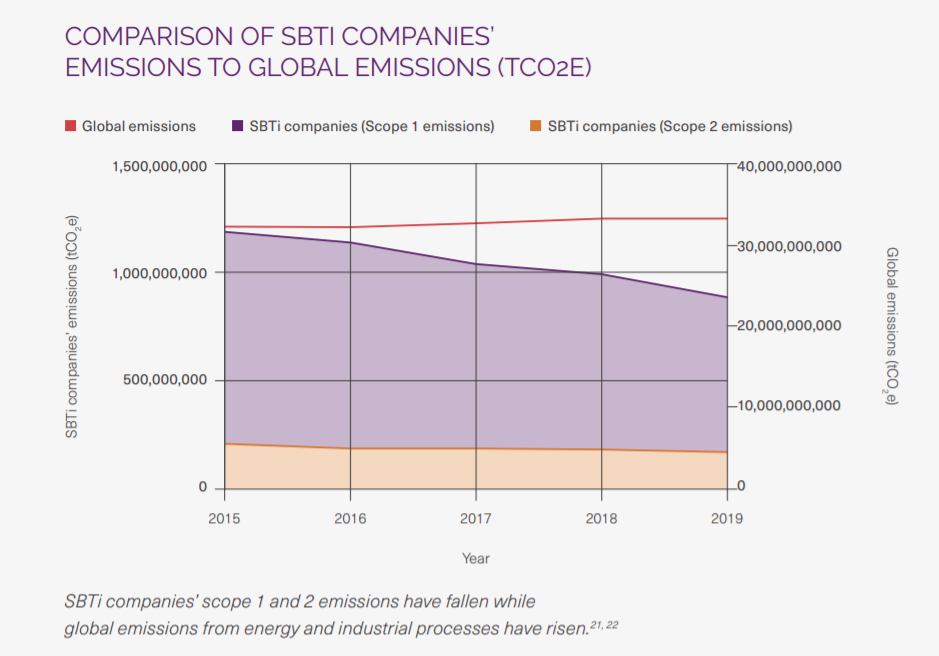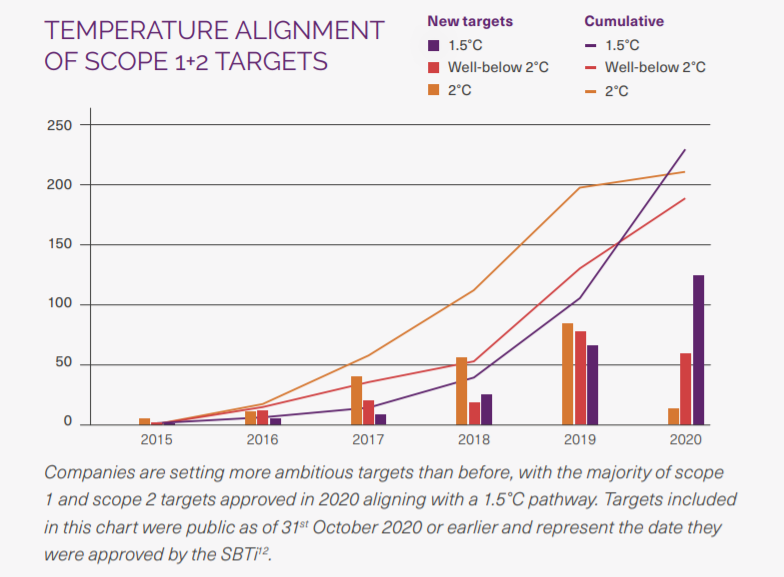Companies are setting emission-reduction targets right and left. But the complex wording and reporting can sometimes make it difficult to discern if companies are living up to their sustainability goals.
The Science Based Targets initiative (SBTi) was launched after the 2015 Paris Agreement to “mobilize the private sector to take the lead on urgent climate action” by analyzing emission-reduction targets based on the most rigorous climate change science available.
SBTi is a partnership among CDP (formerly the Carbon Disclosure Project), the United Nations Global Compact, World Resources Institute and World Wide Fund for Nature. SBTi is also one of the We Mean Business coalition commitments.
The SBTi has a focus on the freight, transportation and supply chain sectors because transportation-related emissions account for about 25% of global greenhouse gas emissions. Emissions from supply chains are, on average, 11.4 times larger than a company’s operational emissions, according to the SBTi.
There is policy and technology progress being made to decarbonize the “significant” and “fast-growing” industry of freight, Fernando Rangel Villasana, senior technical manager at SBTi, told FreightWaves.
“It’s not about a sector focus only. We accept and recognize companies from every trade, and that’s important,” Villasana said.
“Under our approach, we believe that every sector has to make a contribution toward global decarbonization. We look at climate science in general — we have to cut emissions in half by 2030 to have a chance at achieving 1.5 degrees Celsius of average temperature increase [or less], so every sector counts, and we cannot afford not to meet that threshold, which is in the Paris Agreement,” he said.
More than 1,700 companies from 60 countries in 50 different sectors have committed to science-based targets to reduce their environmental footprint.
The 2020 SBTi progress report said that companies with such targets have reduced their combined emissions by 25% since 2015, while global emissions from energy and industrial processes increased by 3.4% over the same period.

Why 1.5 degrees Celsius?
Keeping average global warming levels below 1.5 C will prevent the worst impacts of climate change, according to the Paris Agreement and climate scientists.
The SBTi announced that, beginning July 15, 2022, it will only accept emission-reduction targets in line with the “well below 1.5 degrees C” pathway. Villasana said the recent Intergovernmental Panel on Climate Change report only solidified the initiative’s decision to make more demanding target requirements.
Previously, the initiative accepted targets that were aligned to keep temperatures well below 2 C. Vallasana said this is not the first time the initiative has made its target requirements more stringent, and the targets must evolve as more climate science becomes available.
Villasana said that 66% of all companies that established targets in 2021 set 1.5 C-aligned scope 1 (direct operational emissions) and scope 2 (indirect emissions related to utilities such as electricity and heat) emissions targets.

To align with this temperature target, companies need to reduce emissions by an average rate of 4.2% per year, according to the SBTi. Companies with science-based targets reduce their emissions by approximately 6.4% annually, exceeding the minimum amount needed to reach net-zero emissions by 2050.
Read: Convoy survey: Trucking divided on sustainability, climate change
SBTi impacts on company structure
Villasana said that companies with targets are taking emissions and sustainability into account in core aspects of their operations.
“Companies are internalizing SBTs to the point of having dedicated staff to define the targets, to understand what the science means for them and to internally help them achieve that and track it. That’s actually one of the best examples of how the knowledge has increased and seriousness that corporates have around their SBTs,” Villasana said.
Chief sustainability officers are joining the C suites at major companies, reinforcing the idea that sustainability is a growing concern for companies.
Villasana said it has been encouraging to see awareness and questions for the SBTi grow since he joined the initiative in 2016. “There’s increased awareness of who we are and what we do.”
Net-zero emissions targets
The SBTi recognizes that emissions need to be halved by 2030 and reach net zero by 2050. Net-zero emissions is a balance between the GHG emissions released into and taken out of the atmosphere. One way that companies are getting to net-zero emissions is by purchasing carbon credits to “offset” their emissions.
But there is a lot of confusion and greenwashing in the world of carbon offsets. There is no current body that governs the authenticity and effectiveness of carbon offsets, so there is an uncertain reliability that funding a carbon offsetting project will result in the desired level of carbon reduction.
“The initiative has a clear stance on the use of offsets,” Villasana said. “Offsets are not a part of the emissions scenarios that we explore. In that sense, they can’t count on top of the required reductions for a company operating in a given sector.”
He said carbon credits often fund projects that have sustainability benefits other than emission reduction, so there is some value. SBTi is working on a net-zero emissions standard to provide more credibility to net-zero claims.
“The proliferation of net-zero commitments is a great story. But only those commitments that are real, science-based, and verifiable will be approved by SBTi,” said Tyler Cole, director of carbon intelligence at FreightWaves. “We applaud all firms pursuing SBTs and hope more follow suit. In a sense, that may be inevitable because each new SBT that comes into effect will necessarily have a cascading effect throughout the supply chain. The freight and logistics sector is at the heart of the majority of these value chains and clearly has a large role to play in reducing emissions toward a 1.5 degrees C pathway.”
Click here for more FreightWaves articles by Alyssa Sporrer.
Related Stories:
Biden target: Produce 3B gallons of sustainable aviation fuel by 2030
Freight railroads set green goals
Odyssey Logistics’ sustainability program targets emissions, inefficiency in supply chain
Report: Batteries usually more feasible, environmentally beneficial than green hydrogen







